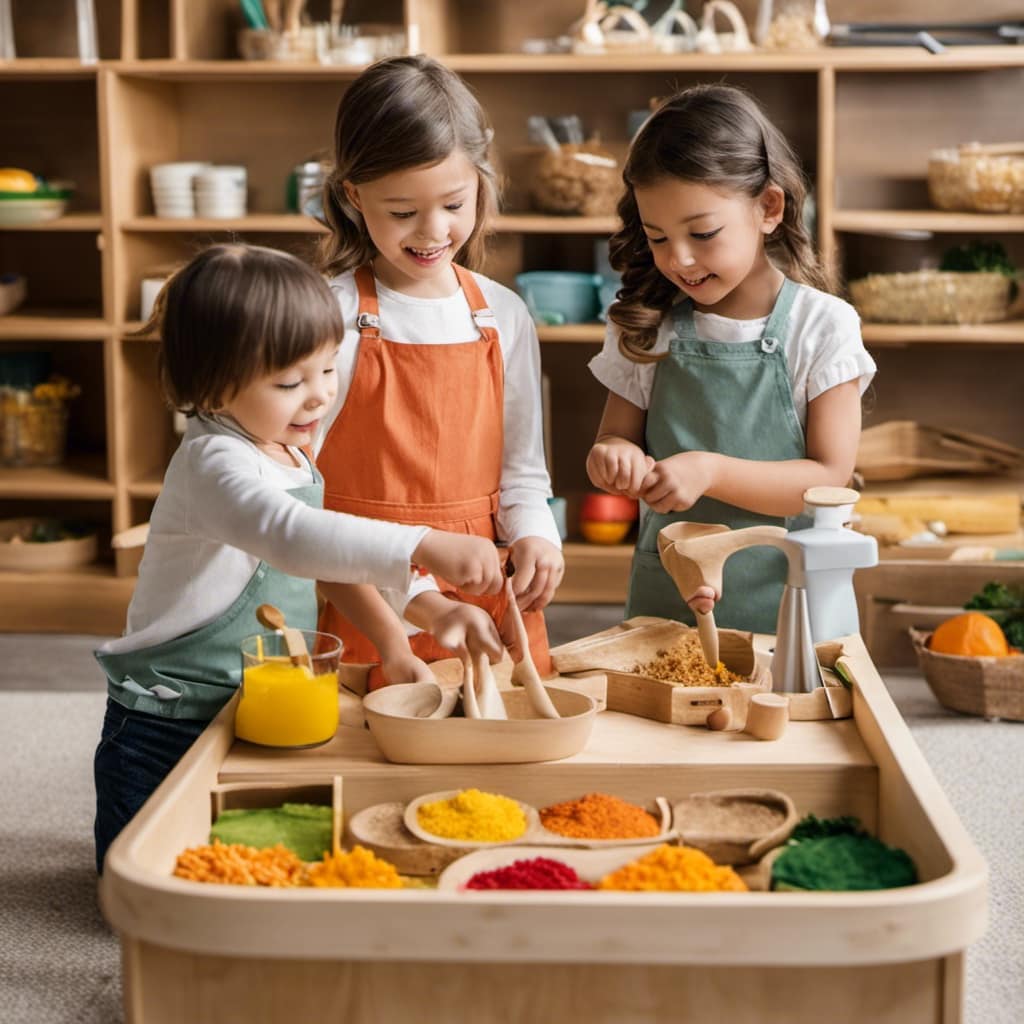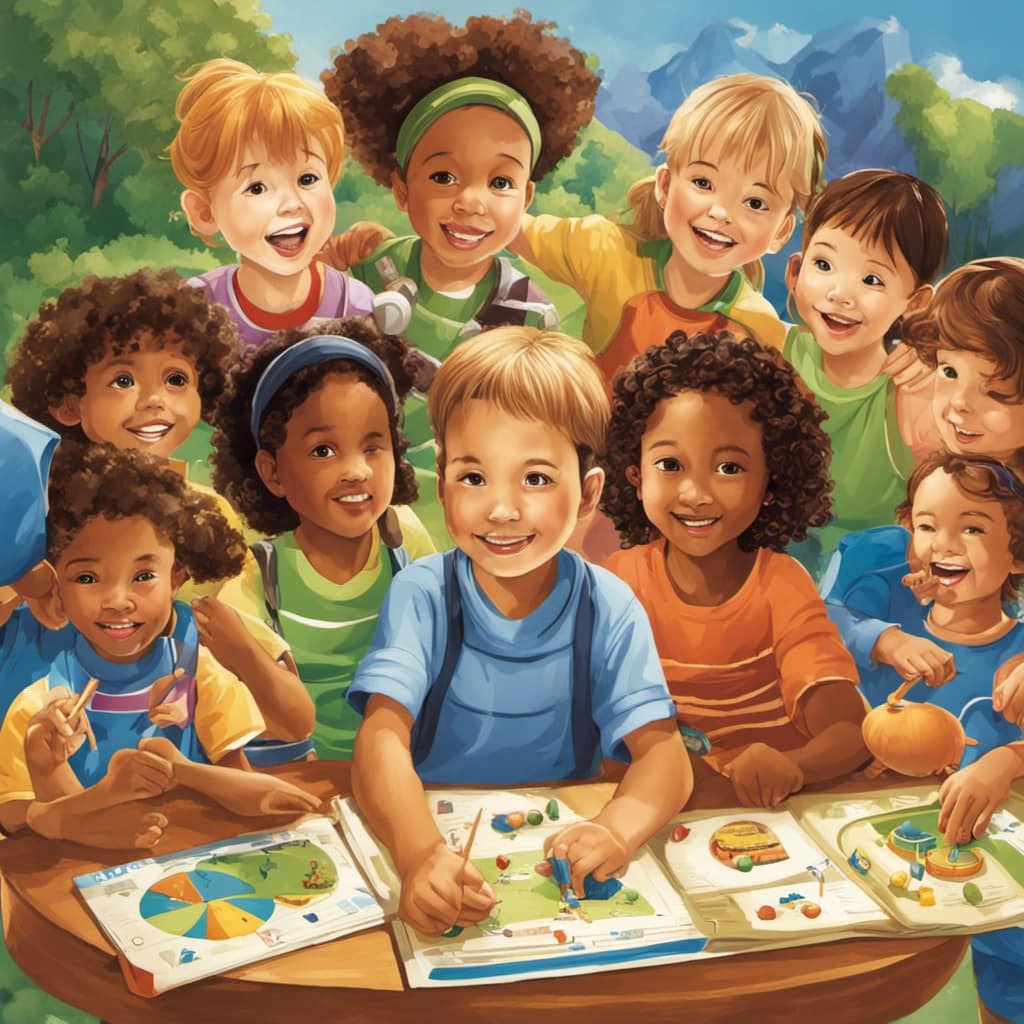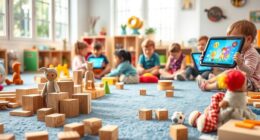Imagine a world where learning goes beyond the traditional classroom setting and passive absorption of information. Instead, it becomes an engaging journey of exploration driven by individual interest and curiosity.
Welcome to the Montessori Method, a revolutionary approach to education that empowers learners of all ages to take ownership of their learning.
In this article, I will take you on a captivating journey through the Montessori Method, where hands-on learning and essential life skills go hand in hand.
Get ready to unlock your potential and embark on an educational adventure like no other.
Key Takeaways
- Montessori Method emphasizes hands-on learning and self-directed exploration.
- Practical life activities teach essential life skills and promote independence and self-confidence.
- Sensorial materials stimulate senses and promote cognitive growth.
- Montessori tools enhance language development and support vocabulary expansion in young learners.
The Importance of Hands-On Learning in Montessori Education
I believe that hands-on learning is crucial in Montessori education because it allows children to actively engage with materials and develop essential life skills.
The benefits of hands-on learning in Montessori education are immense. Practical life activities play a vital role in fostering independence in children. By engaging in activities such as pouring, spooning, and buttoning, children develop fine motor skills, hand-eye coordination, and concentration. These activities lay the foundation for future academic success and boost confidence and competence.

Independence in practical life activities also builds self-esteem, problem-solving skills, and a sense of ownership. Children learn to take care of themselves and their environment, developing essential life skills that will serve them well in the future.
The hands-on nature of Montessori education empowers children to actively explore and discover their own unique abilities and talents, promoting a love for learning and a sense of accomplishment.
Developing Essential Life Skills Through the Montessori Method
Practical life activities in the Montessori approach foster independence and self-confidence by teaching children essential skills for everyday tasks. These activities are designed to develop problem-solving skills and build self-esteem, empowering children to take ownership of their actions and become capable individuals. By engaging in practical life activities, such as pouring, spooning, and buttoning, children enhance their fine motor skills, concentration, and hand-eye coordination. This lays a solid foundation for future academic success, as well as boosting their confidence and competence in facing challenges. The Montessori method recognizes the importance of practical life skills in a child’s overall development and provides a supportive environment for children to explore, discover, and develop their unique abilities and talents. Through these activities, children not only learn essential skills but also gain a sense of accomplishment and independence, building their self-esteem and problem-solving abilities.
| Developing Problem Solving Skills | Building Self Esteem |
|---|---|
| Engaging in hands-on activities | Accomplishing tasks |
| Exploring different solutions | Gaining independence |
| Encouraging independent thinking | Building confidence |
Practical Life Activities: Fostering Independence and Self-Confidence
Engaging in these activities allows me to develop independence and build self-confidence.
In the Montessori method, practical life activities play a crucial role in fostering independence and promoting self-confidence in children.
Through daily tasks like pouring, spooning, and buttoning, children learn essential life skills that empower them to take care of themselves and their environment.

These activities not only enhance fine motor skills and hand-eye coordination but also instill a sense of ownership and accomplishment.
As children gain competence in these practical tasks, they develop problem-solving skills and self-esteem.
The Montessori approach recognizes the importance of independence in nurturing confident individuals who can navigate the world with self-assurance.
Enhancing Cognitive Growth and Perception With Sensorial Materials
Using sensorial materials in the Montessori classroom enhances cognitive growth and perception. These materials are carefully designed to stimulate sensory exploration and promote cognitive development in young learners.
By engaging with materials that offer a variety of textures, colors, shapes, sounds, and scents, children are able to refine their senses and deepen their understanding of the world around them.
For example, the pink tower and knobbed cylinders allow children to discriminate and categorize sensory information, while developing their visual and tactile perception. This hands-on approach to learning not only fosters a love for exploration and discovery but also supports the development of critical thinking skills and problem-solving abilities.

As Montessori educators, we believe in providing opportunities for children to engage their senses, as it lays a strong foundation for their overall cognitive development and helps them become active, curious, and confident learners.
Language Development: Hands-On Tools in the Montessori Classroom
I believe that incorporating hands-on tools in the Montessori classroom is crucial for fostering language development and expanding vocabulary.
Tactile exploration is a powerful way for children to engage with language and make meaningful connections. When children use tools like sandpaper letters, they not only see and hear the letters but also feel their shapes and textures. This multi-sensory experience helps them remember and recognize the letters more effectively.
Language objects are another valuable tool that allows children to associate words with their meanings, expanding their vocabulary. By manipulating moveable alphabets, children can experiment with different letter combinations and form their own sentences.
These hands-on activities empower children to actively participate in their language learning journey, encouraging them to explore, discover, and develop their unique abilities.
With the right tools, language development becomes an exciting and interactive experience for every child.

Montessori Math Materials: Exploring Counting, Addition, and Subtraction
Counting, addition, and subtraction are explored through the use of Montessori math materials, such as golden beads and number rods. These interactive learning tools engage children in hands-on exploration, making numeracy skills come alive. The golden beads, with their vibrant colors and varying quantities, allow children to physically manipulate and visualize numbers as they count and perform addition and subtraction operations. The number rods provide a concrete representation of quantities and help children understand the concept of length and measurement. By using these materials, children actively participate in their learning, developing a deep understanding of mathematical concepts. The table below highlights the key Montessori math materials and their corresponding activities:
| Math Material | Activity |
|---|---|
| Golden Beads | Counting, Addition, Subtraction |
| Number Rods | Measurement, Ordering Numbers |
| Spindle Box | Number Sequencing, Correspondence |
| Addition Strip Board | Addition, Number Patterns |
| Subtraction Strip Board | Subtraction, Number Relationships |
| Stamp Game | Addition, Subtraction, Multiplication |
Exploring numeracy skills through these interactive learning tools not only builds a solid foundation in mathematics but also fosters a love for learning and a sense of accomplishment in young learners.
Cultural Studies in the Montessori Classroom: Expanding Horizons and Appreciating Diversity
In our previous discussion, we explored the wonderful world of Montessori Math Materials, where children engage in hands-on activities to learn about counting, addition, and subtraction. Now, let’s shift our focus to another exciting aspect of the Montessori classroom – Cultural Studies.
Cultural Studies in the Montessori Classroom is all about expanding horizons and appreciating diversity. Here are three reasons why this area of exploration is so important:
- Geography Exploration:
- Puzzle maps allow children to learn about different countries, their shapes, and locations.
- Flag cards help children recognize and identify flags from around the world.
- Landmark replicas enable children to explore famous landmarks and their cultural significance.
- Cultural Diversity Appreciation:
- Cultural cards and books introduce children to diverse traditions, customs, and languages.
- Celebrating cultural holidays and festivals fosters an understanding and appreciation of different cultures.
- Encouraging discussions and sharing personal stories promote empathy, respect, and acceptance.
- Global Citizenship Development:
- Learning about different cultures helps children develop a sense of global citizenship.
- Understanding cultural diversity promotes open-mindedness and inclusivity.
- Exploring cultures builds a foundation for fostering peace and creating a harmonious world.
Incorporating Cultural Studies in the Montessori curriculum allows children to explore the world around them, appreciate cultural diversity, and develop a global perspective. It empowers them to become compassionate, open-minded, and respectful individuals who can contribute positively to our diverse society.
Frequently Asked Questions
How Does the Montessori Method Promote Social Interaction Among Children?
The Montessori Method promotes social interaction among children by emphasizing collaboration and fostering empathy. Through activities and materials, children learn to work together, communicate effectively, and understand and respect each other’s perspectives and feelings.

What Are the Benefits of Using Self-Correcting Materials in Montessori Math Education?
Using self-correcting materials in Montessori math education has numerous benefits. Children can independently identify and correct mistakes, promoting problem-solving skills and confidence. This hands-on approach fosters a deeper understanding of mathematical concepts.
How Do Practical Life Activities in Montessori Classrooms Contribute to the Development of Problem-Solving Skills?
Practical life activities in Montessori classrooms foster problem-solving skills by promoting independence and critical thinking. Through activities like pouring and buttoning, children develop problem-solving strategies, boost confidence, and learn to take ownership of their actions.
Can You Provide Examples of Language Objects Used in Montessori Education?
In Montessori education, language objects are used to expand vocabulary and associate words with meanings. They include objects like animals, fruits, and household items, providing hands-on learning experiences and promoting language development.
How Does Montessori Education Incorporate Cultural Studies Into the Curriculum?
Incorporating cultural studies in Montessori education involves cultural integration and multicultural exploration. Through puzzle maps, cultural cards, and books, children learn about geography, flags, landmarks, traditions, customs, and languages from around the world.
Conclusion
In conclusion, the Montessori Method offers a rich and dynamic approach to education. It provides hands-on learning experiences that foster essential life skills and promote holistic development. Like a guiding light, it empowers learners to explore, discover, and develop their unique abilities. This method inspires them to reach new heights.
With its inclusive and engaging style, the Montessori Method ensures that every learner feels valued and encouraged to actively participate in their own learning journey. It provides practical guidance and useful tips, equipping educators and individuals with the tools they need to implement the Montessori Method effectively. By doing so, they can make a positive impact in their lives and educational settings.












